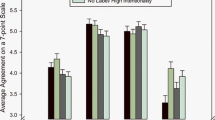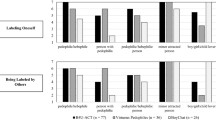Abstract
In the present research, we addressed the question of whether people harbor punitive attitudes against individuals sexually interested in children even if no sexual offense is mentioned and whether this effect is amplified by the clinical label pedophilia. In two online studies (total N = 345), participants rated the extent to which they saw individuals sexually interested in children as necessarily committing child sexual abuse (dangerousness), responsible for their sexual interest (intentionality), and clinically disordered (deviance) before judging their endorsement of means of punishment (punitive attitudes). Participants were randomly assigned to one of two conditions in which either the “pedophilia” label or the descriptive term “sexual interest in (prepubescent) children” was included in all items. Across both studies, results showed high degrees of punitive attitudes against sexually deviant men, an effect that was particularly pronounced if the pedophilia label was present. Whereas this was only latently observable in Study 1 (concealed by a suppression effect of reduced ascriptions of intentionality), in Study 2 no such suppression was observed. Unlike any other stigma we know of, punitive attitudes against pedophiles were associated positively with social desirability, suggesting that participants saw it as particularly socially desirable to condemn someone based on their deviant sexual interest.


Similar content being viewed by others
References
Ames, M. A., & Houston, D. A. (1990). Legal, social, and biological definitions of pedophilia. Archives of Sexual Behavior, 19, 333–342. doi:10.1007/BF01541928.
Beier, K. M., Ahlers, C. J., Goecker, D., Neutze, J., Mundt, I. A., Hupp, E., et al. (2009). Can pedophiles be reached for primary prevention of child sexual abuse? First results of the Berlin Prevention Project Dunkelfeld (PPD). Journal of Forensic Psychiatry & Psychology, 20, 851–867. doi:10.1080/14789940903174188.
Buhrmester, M., Kwang, T., & Gosling, S. D. (2011). Amazon’s Mechanical Turk: A new source of inexpensive, yet high-quality, data? Perspectives on Psychological Science, 6, 3–5. doi:10.1177/1745691610393980.
Conger, A. J. (1974). A revised definition for suppressor variables: A guide to their identification and interpretation. Educational Psychological Measurement, 34, 35–46. doi:10.1177/001316447403400105.
Feelgood, S., & Hoyer, J. (2008). Child molester or pedophile? Sociolegal versus psychopathological classification in sexual offender research. Journal of Sexual Aggression, 14, 33–43.
Feldman, D. B., & Crandall, C. S. (2007). Dimensions of mental illness stigma: What about mental illness causes social rejection? Journal of Social and Clinical Psychology, 26, 137–154. doi:10.1521/jscp.2007.26.2.137.
Golec de Zavala, A., Cichocka, A., & Bilewicz, M. (2013). The paradox of in-group love: Differentiating collective narcissism advances understanding of the relationship between in-group and out-group attitudes. Journal of Personality, 81, 16–28. doi:10.1111/j.1467-6494.2012.00779.x.
Hall, R. C. W., & Hall, R. C. W. (2007). A profile of pedophilia: Definition, characteristics of offenders, recidivism, treatment outcomes, and forensic issues. Mayo Clinic Proceedings, 82, 457–471. doi:10.4065/82.4.457.
Harper, C. A., & Hogue, T. E. (2014a). The emotional representation of sexual crime in the national British press. Journal of Language and Social Psychology. doi:10.1177/0261927X14544474.
Harper, C. A., & Hogue, T. E. (2014b). A Prototype-Willingness model of sexual crime discourse in England and Wales. The Howard Journal of Criminal Justice. doi:10.1111/hojo.12095.
Harrison, K., Manning, R., & McCartan, K. (2010). Multi-disciplinary definitions and understandings of ‘paedophilia’. Social & Legal Studies, 19, 481–496. doi:10.1177/0964663910369054.
Heatherton, T., Kleck, R., Hebl, M., & Hull, J. (2000). The social psychology of stigma. New York: Guilford Press.
Henderson, C., Evans-Lacko, S., Flach, C., & Thornicroft, G. (2012). Responses to mental health stigma questions: The importance of social desirability and data collection method. The Canadian Journal of Psychiatry, 57, 152–160.
Imhoff, R. (2014). Zeroing in on the effect of the schizophrenia label on stigmatizing attitudes: A large scale study. Manuscript submitted for publication.
Imhoff, R., & Banse, R. (2009). Ongoing victim suffering increases prejudice: The case of secondary anti-semitism. Psychological Science, 20, 1443–1447. doi:10.1111/j.1467-9280.2009.02457.x.
Jahnke, S., & Hoyer, J. (2013). Stigmatization of people with pedophilia: A blind spot in stigma research. International Journal of Sexual Health, 25, 169–184.
Jahnke, S., Imhoff, R., & Hoyer, J. (2014). Stigmatization of people with pedophilia: Two comparative surveys. Archives of Sexual Behavior. doi:10.1007/s10508-014-0312-4.
Lam, A., Mitchell, J., & Seto, M. C. (2010). Lay perceptions of child pornography offenders. Canadian Journal of Criminology and Criminal Justice, 52, 173–201. doi:10.1353/ccj.0.0087.
Link, B. G., Cullen, F. T., Struening, E., Shrout, P. E., & Dohrenwend, B. P. (1989). A modified labeling theory approach to mental disorders: An empirical assessment. American Sociological Review, 54, 400–423. doi:10.2307/2095613.
MacKinnon, D. P., Krull, J. M., & Lockwood, C. M. (2000). Equivalence of the mediation, confounding and suppression effect. Prevention Science, 1, 173–181. doi:10.1023/A:1026595011371.
Mancini, C., & Mears, D. P. (2010). To execute or not to execute? Examining public support for capital punishment of sex offenders. Journal of Criminal Justice, 38, 959–968. doi:10.1016/j.jcrimjus.2010.06.013.
Marshall, W. L. (1997). Pedophilia: Psychopathology and theory. In R. D. Laws & W. O’Donohue (Eds.), Sexual deviance: Theory, assessment, and treatment (Vol. 1, pp. 152–174). New York: Guilford Press.
Maruna, S., & King, A. (2009). Once a criminal, always a criminal? ‘Redeemability’ and the psychology of punitive public attitudes. European Journal on Criminal Policy and Research, 15, 7–24. doi:10.1007/s10610-008-9088-1.
McCartan, K. (2004). ‘Here there be monsters’: The public’s perception of paedophiles with particular reference to Belfast and Leicester. Medicine, Science and the Law, 44, 327–342. doi:10.1258/rsmmsl.44.4.327.
Paulhus, D. L., Robins, R. W., Trzesniewski, K. H., & Tracy, J. L. (2004). Two replicable suppressor situations in personality research. Multivariate Behavioral Research, 39, 303–328. doi:10.1207/s15327906mbr3902_7.
Penn, D. L., & Nowlin-Drummond, A. (2001). Politically correct labels and schizophrenia. Schizophrenia Bulletin, 27, 197–203. doi:10.1093/oxfordjournals.schbul.a006866.
Preacher, K. J., & Hayes, A. F. (2004). SPSS and SAS procedures for estimating indirect effects in simple mediation models. Behavior Research Methods, Instruments, & Computers, 36, 717–731. doi:10.3758/BF03206553.
Preacher, K. J., & Kelley, K. (2011). Effect size measures for mediation models: Quantitative strategies for communicating indirect effects. Psychological Methods, 16, 93–115. doi:10.1037/a0022658.
Ray, J. J. (1984). The reliability of short social desirability scales. Journal of Social Psychology, 123, 133–134.
Scheff, T. (1999). Being mentally ill: Sociological theory (3rd ed.). Piscataway, NJ: Aldine Transaction.
Schmidt, A. F., Gykiere, K., Vanhoeck, K., Mann, R. E., & Banse, R. (2014). Direct and indirect measures of sexual maturity preferences differentiate subtypes of child sexual abusers. Sexual Abuse: A Journal of Research and Treatment, 26, 107–128. doi:10.1177/1079063213480817.
Seto, M. C. (2008). Pedophilia and sexual offending against children: Theory, assessment, and intervention. Washington, DC: American Psychological Association. doi:10.1037/11639-000.
Shapiro, D. N., Chandler, J., & Mueller, P. A. (2013). Using Mechanical Turk to study clinical populations. Clinical Psychological Science, 1, 213–220. doi:10.1177/2167702612469015.
Spieckera, B., & Steutela, J. (1997). Paedophilia, sexual desire and perversity. Journal of Moral Education, 26, 331–342. doi:10.1080/0305724970260307.
Viki, G. T., Fullerton, I., Raggett, H., Tait, F., & Wiltshire, S. (2012). The role of dehumanization in attitudes toward the social exclusion and rehabilitation of sex offenders. Journal of Applied Social Psychology, 42, 2349–2367. doi:10.1111/j.1559-1816.2012.00944.x.
Acknowledgments
I would like to thank Sara Jahnke for valuable comments and the productive collaboration in constructing the scales.
Author information
Authors and Affiliations
Corresponding author
Rights and permissions
About this article
Cite this article
Imhoff, R. Punitive Attitudes Against Pedophiles or Persons With Sexual Interest in Children: Does the Label Matter?. Arch Sex Behav 44, 35–44 (2015). https://doi.org/10.1007/s10508-014-0439-3
Received:
Revised:
Accepted:
Published:
Issue Date:
DOI: https://doi.org/10.1007/s10508-014-0439-3




